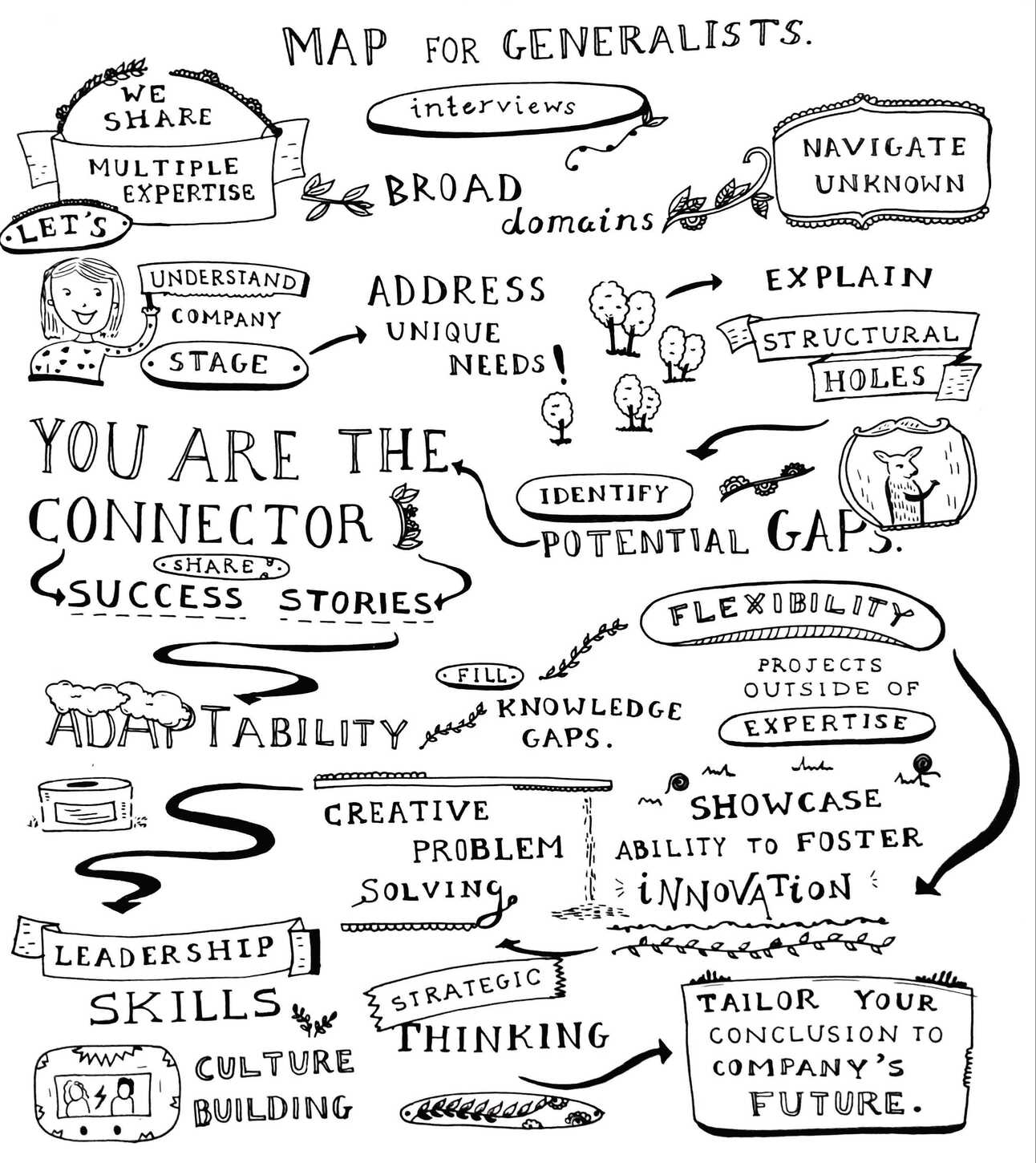💡How to leverage the Structural Hole Theory
Building Generalist World has been an ongoing series of ‘click’ moments. My job is to watch out for them, piece them together, and then roll them up in a lovely little bow and deliver them to you in an essay. Today, I have one that’ll help you stand out in interviews 🎁
🍪 Your task: screenshot the parts of this essay that resonate most, and tag us on Linkedin @generalistworld — we’ll help amplify your post
Recently, Nikita and I ran a workshop in London for folks to work through the Generalist Job Search Guidebook together. It was fantastic!
My first ‘click moment’ happened when Karl Eastwood said something in passing, that has been ringing in my mind ever since.
I’ve been mulling it over, connecting the dots, and I think it could really help you find your edge in interviews. I hope it helps!

🧵 The Structural Hole Theory
Structural hole theory is a concept from social network research, originally developed by Ronald Stuart Burt. I’m building off that, and applying it to a different domain: business.
Here’s how I’m thinking about it..
Companies silo as they scale, creating structural holes that fracture efficiency, decrease collaboration and slo down innovation. This creates a big problem for growing businesses and a big opportunity for connectors to weave solutions that mitigate the gaps.
💡 What a company size/stage really translates to
In Karl’s words:
A team of 50: All in it together. Friends start to fracture into smaller social groups, very early employees feel disconnected from access to CEO like they used to have
A team of 150: Dunbar number, inability to maintain more than 150 friendships, there’s lots written on this being the maximum size for units/villages/tribes etc (listen to "The Social Brain" for more). Early-stage employees feel the company has changed from what they knew.
A team of 300: Usually in the midst of fast-scaling and fast-hiring, influx of people rapidly can lead to culture drifting quickly. People join not just because of the vision, but because it is fast-growing or and it’s hiring. Keeping the culture of a business and preventing siloing of departments is hard, duplication of work etc creeps in here.
A team of 500: Rapid growth, has still all the same issues but investors (thinking start-ups here) will start to be thinking about IPO etc and corporate governance and structuring requirements will start to creep in
First takeaway? Company stage really matters, and each growth stage comes with its own set of (potentially) existential problems. Use this knowledge to your advantage.
💡 My next ‘click moment’ happened when Susanna said: “I have found my niche: companies (and people) in transition”
It’s no secret. Generalists thrive in ambiguity. So if this is our sweet spot, I thought, hey, where can we find breeding grounds of deep ambiguity? The answer: in stages of transition.
So, armed with this, what happens if you lean into this? Using it to your advantage during interviews?
Your edge is that you have multiple expertise, high EQ, AND you can navigate seasons of the unknown.
This, my generalist friends, is going to be music to a CEO’s ears.

⚡ How to leverage the Structural Hole Theory in interviews
So how might this play out in an interview setting? Putting on my founder / CEO hat, if someone came to me armed with this level of preparation I’d be blown away. Here’s what you can do…
1. Permissionless diagnosis
Research + diagnose: Before the interview, research the company to understand its current size and the specific challenges it faces at its growth stage. What can you learn about their progress from LinkedIn? From their blogs? From their employee’s posts? Read between the lines, and tailor your approach to address the unique needs of companies at the 50, 150, 300, or 500-employee milestones.
Be a mind reader: Acknowledge the company's current stage and have a clear hypothesis of what challenges they’re facing. For example, "given your team is approaching the 150-employee mark, I know from experience maintaining a cohesive culture across departments is top of mind”. Your goal here? Appear to be a mind reader. You want the hiring manager to take a beat and say, “whoa, that’s exactly what we’re facing”.
2. Position yourself as the thread that ties everything together:
(shoutout Lucy for this ongoing perfect analogy!)
Call out gaps: Suggest hypothetical examples of structural holes that might exist within the company, based on your research. Importantly, be ready to give high-level solutions of how you would approach solving these gaps.
Sell your squiggle: Package your most relevant, diverse experiences (note: this doesn’t mean a laundry list of ALL your experiences. Start with the most compelling and work backwards). Explain how this skill-set equips you to act as a bridge within the company, bringing together different teams or departments that might not typically collaborate.
3. Show, don’t tell
Focus on data-backed outcomes: Share specific instances from your career where you successfully connected disparate groups to achieve a common goal, emphasizing the outcomes and transformations.
EVERYONE knows can figure it out
spots problems before they happen
breaks down silos and speeds up progress
connects the dots and sees a new, unexpected way forward
4. You’re not a nice-to-have, you’re essential
Your generalism is a key asset: Your job-to-be-done during the interview is to explain how it’s precisely your diverse background that makes you an expert in building X, Y, or Z, specifically through periods of significant change. There’s huge upside to having you on the team. Don’t be shy in naming that.
Help them operate like a startup: As companies scale they become slower and less efficient. They’ll be longing for the early, agile days of speedy development. Explain how you’ll use your wide-ranging experiences to ensure the company remains agile and forward-thinking. As always, use concrete examples.
5. Set clear, tangible outcomes and paint the path to get there
The cherry on top: Conclude by aligning your generalist strengths with the company’s long-term goals and challenges, emphasizing how you can help navigate future growth stages beyond the current headcount.
Be specific: Tie it back to the Structural Hole they’re facing: “from what I’ve heard so far, I think we can execute on A, B, and C, and in doing so we could reach Goal 1 by Q1 2025. Here’s how I’d approach it in the first 6 weeks and 6 months….”.
👋 Post-Interview:
Follow-up, always: Send a personalized thank you note. Include your top 2-3 things you’re most excited about executing on, as well as any ‘post-interview’ thoughts that have brewed. Avoid any language and references that are generic. This note should inspire “OH YES, this person, they’re a stand out”.
Be unignorable: Comment on their LinkedIn update. Reply to their marketing email. Retweet their post etc. Have your name pop up again and again so they say internally, hey this person is the real deal!
👊 You got this
Lastly, you got this. Being a generalist isn't being mediocre at lots of things, and it's not knowing a tiny bit about alot. It's about being: The Full Stack Everything. Lean in. Own it. And come celebrate with me when you’ve signed on the dotted line 🎉
1 month till we open our community doors! Want to get first dibs on an invite?
📚 PS: a must-read:
In her book, The Silo Effect, Gillian Tett argues
“we live in such a complex world humans need structure to handle this complexity. The simplest way is to put ideas, people and data into separate spatial, social and mental boxes. But silos can also cause damage. People who are organised into specialist teams can end up fighting with each other, & wasting resources.
Isolated departments, or teams of experts, may fail to communicate, and thus overlook dangerous and costly risks. Fragmentation can create information bottle-necks and stifle innovation. Above all else, silos can create tunnel vision, or mental blindness, which causes people to do stupid things”.

Founder & CEO Generalist World
📍I live and work from a tiny island in the Scottish Highlands
